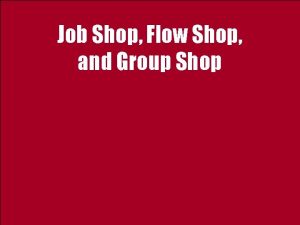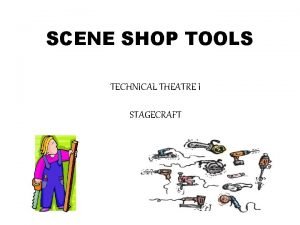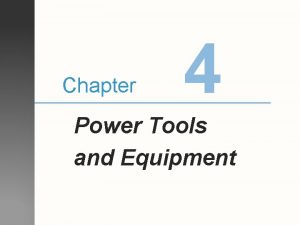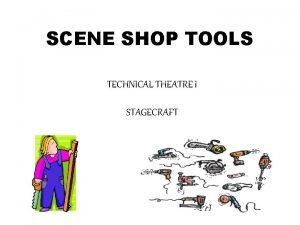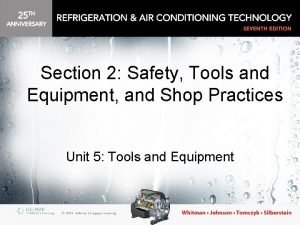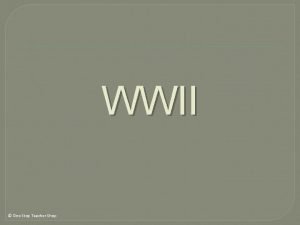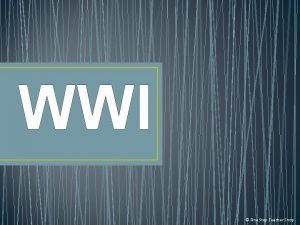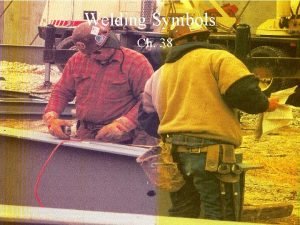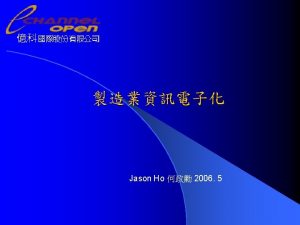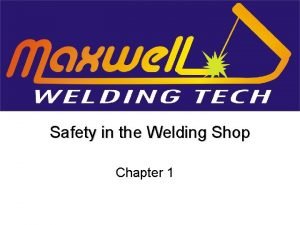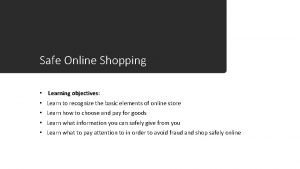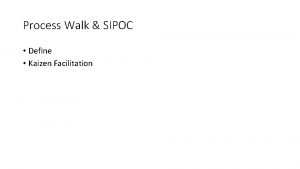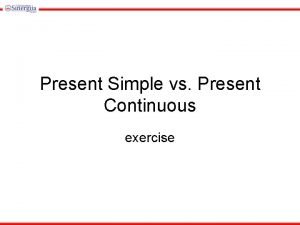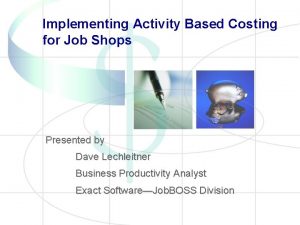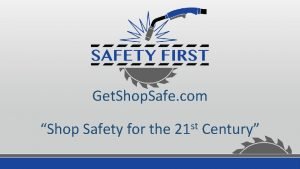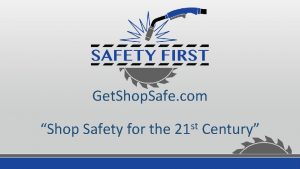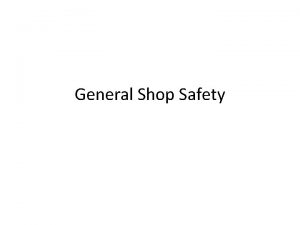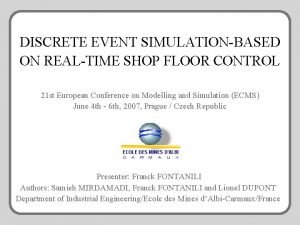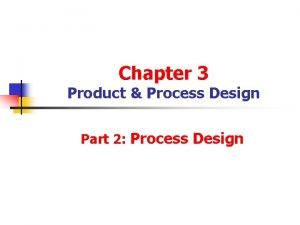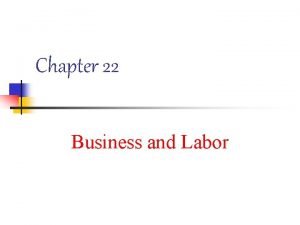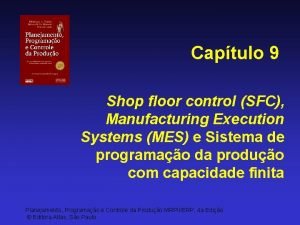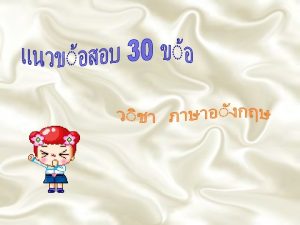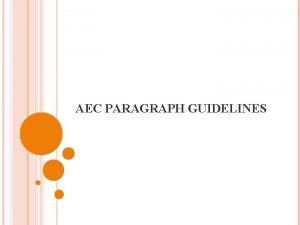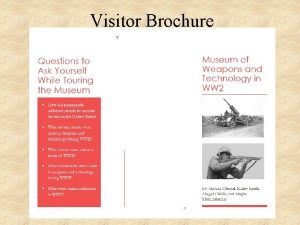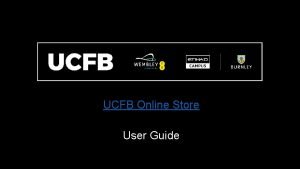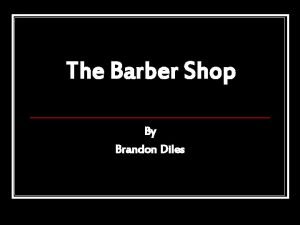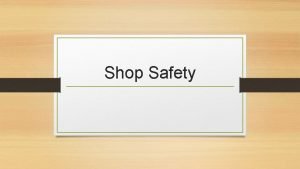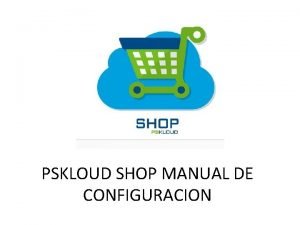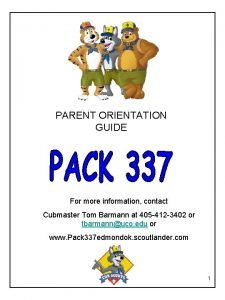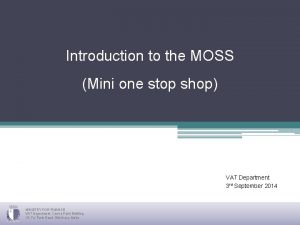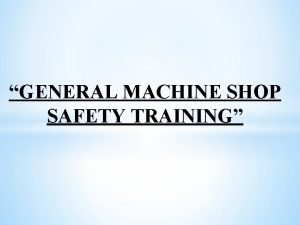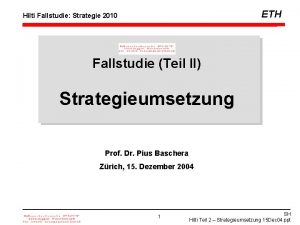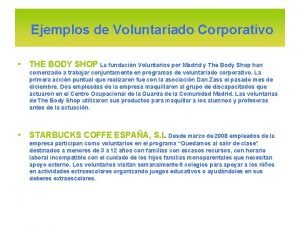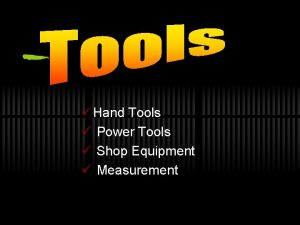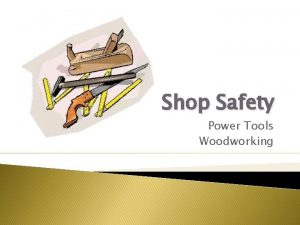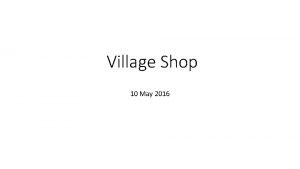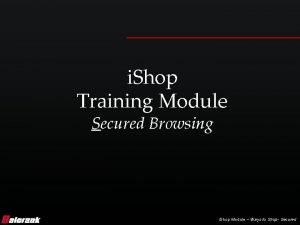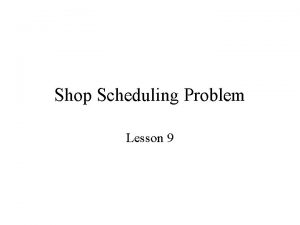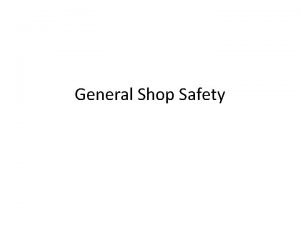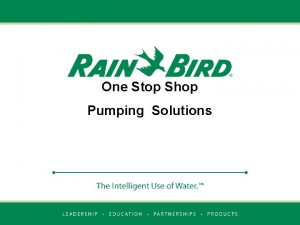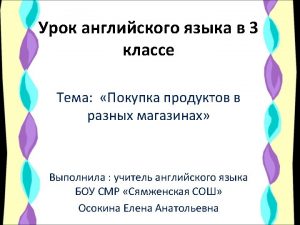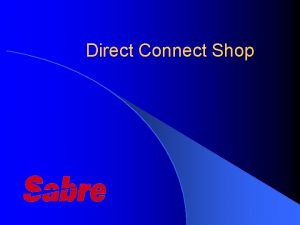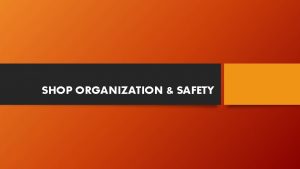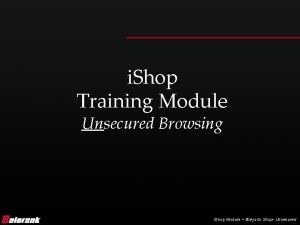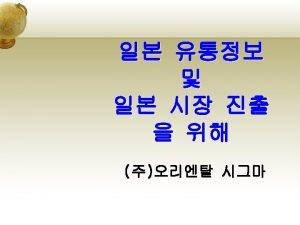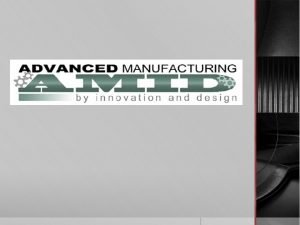UNIT 2 SHOP TOOLS Unit 2 Shop Tools

































































- Slides: 65

UNIT 2: SHOP TOOLS

Unit 2: Shop Tools LESSON 3: POWER SHOP EQUIPMENT

UNIT INFORMATION Unit 2: Materials • Lesson 1: Hand Tools • Lesson 2: Portable Hand-held Power Tools • Lesson 3: Power Shop Equipment Course Description • This course will identify manufacturing tasks that may require installed power shop equipment to accomplish such things as drilling, grinding, cutting, sanding, and trimming. You will also be introduced to common power shop equipment and machinery, including the drill press, disk sander, belt sander, pedestal grinder, band saw, and the manual foot shear. You’ll become familiar with safety considerations for the use, features, and normal operating techniques.

LESSON OBJECTIVES At the completion of this lesson you will be able to • Know general safety hazards associated with the operation of installed power shop equipment. • List workplace tasks or functions that require power shop equipment to accomplish. • Explain basic techniques and proper use of common power shop equipment and machinery, including the drill press, disk sander, belt sander, pedestal grinder, band saw, and the manual foot shear. • Explain the potential hazards of each individual power shop machine.

POWER SHOP EQUIPMENT AND MACHINERY Safety Tag-Out Drill Press Disc Sander Belt Sander Pedestal Grinder Manual Foot Shear Band Saw 5

LESSON PREVIEW Safety Tag-Out Tools Instructor Demonstration Practice Review 6

SAFETY GUIDELINES FOR POWER SHOP EQUIPMENT & MACHINERY

SAFETY GUIDELINES FOR POWER SHOP EQUIPMENT & MACHINERY You are responsible for your own safety.

SHOP SAFETY BASICS – DO: Wear safety glasses with side shields. Use hand tools for their designed purposes only. Wear boots or safety shoes. Pull back and secure long hair. Roll up your sleeves to your elbows. Wear an apron tied in a quick release manner. 9

SHOP SAFETY BASICS – DON’T: DON’T wear DON’T work DON’T get too loose clothing, alone in a close to moving neckwear or machine shop machine parts exposed jewelry. (buddy system). and work pieces. DON’T use defective machinery, equipment or hand tools. DON’T wear loose clothing, neckwear or exposed jewelry. 10

IMPORTANT REMINDERS No gloves are to be used with power island equipment. • This includes ergo-type mechanic gloves Double eye protection required when using all power island tools. Hearing protection or extra hearing protection may be needed.

TAG - OUT Safety Tag-Out Tools Instructor Demonstration Practice Review 12

TAG-OUT 1, 2, 3 If a machine is: • • Damaged Not working Needs adjustment Does not pass your safety inspection 1. Tag-Out 2. Lock-Out 3. Notify

LOCK-OUT, TAG-OUT L-O-T-O

TOOLS Safety Tag-Out Tools Instructor Demonstration Practice Review 15

POWER SHOP EQUIPMENT AND MACHINERY 1. 2. 3. 4. 5. 6. Drill Press Disc Sander Belt Sander Pedestal Grinder Band Saw Foot Shear

DRILL PRESS

DRILL PRESS FUNCTION A Drill Press allows the operator to drill holes in material by lowering a rotating cutter onto materials such as wood, ferrous and non-ferrous metals and composites.

DRILL PRESS POTENTIAL HAZARDS Entanglement Material falling from the work table Poor housekeeping Struck by chips, coolant, broken cutter fragments of other flying objects Flying chuck keys Contact with moving machine parts Being struck by work that has seized Hand injuries from debris or sharp cutters 19

DRILL PRESS SAFETY CONTROLS 1 1. Remove chuck key after securing tool. 2. Down stroke depth properly adjusted. 3. Electrical disconnect that can be locked out.

DRILL PRESS SAFETY CONTROLS 2 Make sure: 1. You are using the proper speed for the type and thickness of material. 2. That clamps and vises are in working order and used. 3. That you have adequate lighting. 4. To use a brush rather than compressed air for cleanup. 5. That you use appropriate personal protective equipment (PPE).

DRILL PRESS INSPECTION • • • Guards and shields in place and adjusted Surrounding work area is clean Drill bits properly sharpened Bad tools removed from service “Quick change chucks” never grabbed while rotating Rotation of spindle not to be stopped with hands

DRILL PRESS SAFETY QUESTIONS 1. What are the potential hazards? 2. What safety controls should be taken? 3. What items should you not wear when operating a drill press? 4. What are the inspection steps?

DISC SANDER

DISC SANDER FUNCTION A Disc Sander removes and shapes materials with the abrasive surface of the rotating disc. It is primarily used for faster material removal.

DISC SANDER POTENTIAL HAZARDS • Entanglement • High noise levels • Mixing material dust in the dust collection system (steel and aluminum, metal and wood) • Contact with the rotating abrasive disc • Nip points between running wheel and work table

DISC SANDER SAFETY CONTROLS 1 1. Visible and legible safework-practice placards that warn about mixing incompatible dust 2. Abrasive surface is free of rips, tears, and worn areas 3. Proper type of abrasive disk being used for the material 4. Operational controls clearly marked

DISC SANDER SAFETY CONTROLS 2 Make sure: • • You have adequate lighting provided. Small work pieces are handled with tools. The dust collection system is working. To use appropriate PPE.

DISC SANDER INSPECTION • Guards are in place and properly adjusted • Abrasive surface is free of rips, tears and worn areas • Proper type of abrasive disk being used for the material • Operational controls clearly marked • Surrounding work area clean

DISC SANDER SAFETY QUESTIONS • How does the disc sander create a fire hazard? • What safety controls should be taken? • Does it matter what kind of material you are sanding when using a disc sander? Why or why not? • What are the inspection steps?

BELT SANDER

BELT SANDER FUNCTION Typically 4” to 8” wide, a Belt Sander is the best tool for finishing. It removes material applied against rotating abrasive belt that runs on arrangement of pulleys. Different tools run at differing speeds from 5, 000 to 8, 000 linear feet per minute.

BELT SANDER POTENTIAL HAZARDS Entanglement High noise Mixing incompatible dust in collection system (steel and aluminum) Poor housekeeping Accidental contact with rotating abrasive surface 33

BELT SANDER SAFETY CONTROLS 1 1. Visible and legible safe-work-practice placards with warnings on mixing in compatible dust 2. Unused section of belt below table is guarded 3. Dust collection system is operable

BELT SANDER SAFETY CONTROLS 2 Make sure: • • You have adequate work area lighting Handling devices for small parts You use appropriate PPE Guards are in place and adjusted properly Work area clean Abrasive is free from rip and tears Proper belt being used for material Moving parts are all guarded to prevent access

BELT SANDER SAFETY QUESTIONS 1. How fast can a Belt Sander run? 2. What hazards does the Belt Sander have in common with the Disc Sander? 3. What needs to happen with the belt below the table? 4. Can you use a belt with a small tear?

PEDESTAL GRINDER

PEDESTAL GRINDER FUNCTION A Pedestal Grinder is a grinding machine used to drive abrasive wheels. It is mounted on a pedestal, which is bolted to the floor.

PEDESTAL GRINDER POTENTIAL HAZARDS Exposed moving parts Impact and cutting Electrical hazard Entanglement Exposure to heat, noise, projectiles Exposure to sharp objects, friction and sparks 39

PEDESTAL GRINDER SAFETY CONTROLS 1 1. Inspect the wheels before turning on the power. Do not use wheels that are chipped or cracked. 2. Stand to one side of the wheel when turning on the power. 3. Keep the tool rest as close to the grinding wheel as possible without touching it.

PEDESTAL GRINDER SAFETY CONTROLS 2 1. Prior to adjusting the work rest or tang, unplug the power to the grinder from the wall receptacle. If the grinder is hardwired into a box, follow “OSEH Guideline IHS 011, Lock-out/Tagout – Control of Hazardous Energy Sources. ”

PEDESTAL GRINDER SAFETY CONTROLS 3 Make sure: • To be alert and cautious when a grinding operation requires locating fingers close to the wheel. • That you feed the stock into the wheel with light to medium pressure. Do not force the piece. • That you do not use the side of the grinding wheel to shape stock. • You are standing erect in front of the grinder with both legs straight and slightly apart. Avoid stooping or leaning into the machine.

PEDESTAL GRINDER INSPECTION 1 • Inspect the wheels before turning on the power. Do not use wheels that are chipped or cracked. • Prior to starting the grinder, ensure the tang at the top of the wheel opening is located within 1/4 inch of the wheel. • Prior to starting the grinder, ensure guards enclosing the outside of grinding wheel are in place.

PEDESTAL GRINDER INSPECTION 2 • Be alert and cautious when a grinding operation requires locating fingers close to the wheel. • Feed the stock into the wheel with light to medium pressure. Do not force the piece. • Do not use the side of the grinding wheel to shape stock. • Stand erect in front of the grinder with both legs straight and slightly apart. Avoid stooping or leaning into the machine.

PEDESTAL GRINDER SAFETY QUESTIONS 1. The Pedestal Grinder cannot be used for what material? 2. What new hazards are introduced with a Pedestal Grinder? 3. What do you do if you find a crack on a wheel? 4. What do you use to grind small parts?

BAND SAW

BAND SAW FUNCTION A Band Saw is used to cut material at various angles and shapes. Use it to quickly remove excessive material, and/or to roughly shape a piece of material.

BAND SAW POTENTIAL HAZARDS Entanglement Poor housekeeping Flying dust, chips or particles Accidental contact with moving parts or blade Danger from broken saw blades 48

BAND SAW SAFETY CONTROLS 1

BAND SAW SAFETY CONTROLS 2 Make sure: • You have adequate lighting • You see a visible safe-work-practice placard • There are Push Sticks for smaller pieces of material • The dust collection system is working • Pulleys are properly guarded • There is an enclosure around unused portion of the blade • You use proper PPE

BAND SAW

BAND SAW INSPECTION • • • Guards are in place and secured Blade is correct for material being cut Blade is not dull, damaged or gummed up Work area clean Exposed cutting blade is no more than ¼ Opening in filler plates no more than 1/8 on either side

BAND SAW SAFETY QUESTIONS 1. What new hazards are introduced with a Band Saw? 2. What is the maximum distance from the material to be sawed? 3. Can you use shop air to clean a Band Saw? 4. What are Push Sticks used for?

SHEARS HAND OPERATED SHEAR MANUAL FOOT SHEAR

SHEARS FUNCTION Shears accurately and quickly cut and score sheets of metal.

MANUAL FOOT SHEAR SAFETY QUESTIONS 1. What are the inspection steps for the Manual Foot Shear? 2. What is the maximum thickness of material that can be cut? 3. If you are not strong enough to cut through the material with one foot, can you stand on the Foot Shear pedal with both feet? 4. What type of tape should be on the foot pedal?

INSTRUCTOR DEMONSTRATION Safety Tag-Out Tools Instructor Demonstration Practice Review 57

INSTRUCTOR DEMONSTRATION

PRACTICE REVIEW Safety Tag-Out Tools Instructor Demonstration Practice Review 59

LESSON 3 PRACTICE REVIEW 1 Do you know the answers? What is the maximum gap allowed between the What is the What are the tool rest and the approved method for adjustments you may work surface for the holding parts while make to a band saw? disk sander, belt using a drill press? sander, and the pedestal grinder? 60

LESSON 3 PRACTICE REVIEW 2 Do you know the answers? How high should the blade guard be when using a Band Saw? May gloves be worn while working with power equipment? In addition to safety glasses, what must also be worn when working with power equipment? 61

LESSON 3 PRACTICE REVIEW 3 Do you know the answers? What should be Who is authorized used to hold small What should be to make repairs parts when removed before and major working with a starting a Drill adjustments to Disk or Belt Press? power tools? Sander, or a Pedestal Grinder? 62

SUMMARY Now that you have completed this lesson you are able to • Articulate general safety hazards associated with the operation of installed power shop equipment. • List workplace tasks or functions that require power shop equipment to accomplish. • Describe and select the appropriate power equipment to accomplish a particular workplace function. • Explain the potential hazards of each individual power shop machine.

SUMMARY (CONT) Additionally, you are able to • List and point to the safety controls used for each power shop machine and items to inspect prior to use. • Specify the features and major components of each shop machine. • Explain basic techniques and proper use of common power shop equipment and machinery, including the drill press, disk sander, belt sander, pedestal grinder, band saw, and the manual foot shear.

Acknowledgements Aerospace Joint Apprenticeship Committee (AJAC), American Society of Metals (ASM), The Boeing Company, National STEM Consortium (NSC), Skills Inc. , Washington Manufacturing Advanced Training Institute (WMATI) About These Materials Copyright © 2015 by Washington Manufacturing Advanced Training Institute (WMATI) The Core. Plus: Manufacturing Skills Curriculum is a collaboration among Boeing and WMATI License Unless otherwise specified, this work is licensed under a Creative Commons Attribution-Share. Alike 4. 0 International License. Attribution and Citation To attribute this course please reference Washington Manufacturing Advanced Training Institute (WMATI). Some of the slide deck, activities, and lab projects are derivative works used under CC-BY 4. 0. National Stem Consortium. (2015). Composites Technology certificate program of the National STEM Consortium. Retrieved from http: //oli. cmu. edu. Some slide decks, activities, and lab projects are derivative works used under CC-BY 4. 0. Aerospace Joint Apprenticeship Committee. (2015). Manufacturing Academy. To cite this course please use the following citation example: Washington Manufacturing Advanced Training Institute (WMATI). Core. Plus Manufacturing Skills Curriculum: Precision Measurement course. [URL if applicable. ] Core. Plus, 2015. Disclaimer This workforce solution was built from open license materials from many sources. There are no guarantees, warrantees, or assurances of any kind, express or implied, with respect to such information, including any information on linked sites and including, but not limited to, accuracy of the information or its completeness, timeliness, usefulness, adequacy, continued availability, or ownership.
 Job shop flow shop
Job shop flow shop Tools used in theatre
Tools used in theatre Chapter 4 power tools and equipment
Chapter 4 power tools and equipment Scene shop tools
Scene shop tools Unit 10, unit 10 review tests, unit 10 general test
Unit 10, unit 10 review tests, unit 10 general test Marking tools in sewing
Marking tools in sewing Unit 5 tools and equipment
Unit 5 tools and equipment One stop teacher shop
One stop teacher shop One stop teacher stop
One stop teacher stop Full penetration butt weld symbol
Full penetration butt weld symbol Color 24112007
Color 24112007 Body shop floor plans
Body shop floor plans The body shop franchises
The body shop franchises The curio shop answer key
The curio shop answer key Tally shop tally solutions
Tally shop tally solutions Floor management
Floor management Welding shop safety test
Welding shop safety test How to learn online shopping
How to learn online shopping Sipoc diagram for coffee shop
Sipoc diagram for coffee shop Present simple
Present simple Mission statement for cupcake business
Mission statement for cupcake business Job shop pricing
Job shop pricing Get shop safe
Get shop safe Get shop safe
Get shop safe General shop safety
General shop safety Ag shop safety
Ag shop safety Shop floor control meaning
Shop floor control meaning Solar shop grafton
Solar shop grafton Job shop batch repetitive or continuous
Job shop batch repetitive or continuous Chapter 22 business and labor
Chapter 22 business and labor Shop floor control (sfc)
Shop floor control (sfc) Britt shop cafe
Britt shop cafe Shop assistant good morning
Shop assistant good morning Aec paragraph examples
Aec paragraph examples Pitch deck coffee shop
Pitch deck coffee shop We can do it
We can do it Ucfb store
Ucfb store Carriage trade shop definition
Carriage trade shop definition One stop teacher shop
One stop teacher shop Barbershop cast
Barbershop cast Dropping gs
Dropping gs Physical hazards
Physical hazards 10 general shop safety rules
10 general shop safety rules Prismaflex crrt troubleshooting
Prismaflex crrt troubleshooting Massey machine shop
Massey machine shop Pskloud panel
Pskloud panel Crrtdr.shop reviews
Crrtdr.shop reviews Crrtdr.shop reviews
Crrtdr.shop reviews Meinders scout shop
Meinders scout shop Nunu pet shop
Nunu pet shop Moss mini one stop shop
Moss mini one stop shop One stop shop
One stop shop The fixed position layout
The fixed position layout Mini one stop shop
Mini one stop shop Goals and objectives of a flower shop
Goals and objectives of a flower shop What do you buy from the shops in exercise 1
What do you buy from the shops in exercise 1 Pinch point safety definition
Pinch point safety definition Shop flow system
Shop flow system Sistema flow shop
Sistema flow shop Hilti shop
Hilti shop Voluntariado empresarial ejemplos
Voluntariado empresarial ejemplos Cat shop
Cat shop Crrtdr
Crrtdr Virelangue portugais
Virelangue portugais City shop shanghai
City shop shanghai Boutique layout design
Boutique layout design
